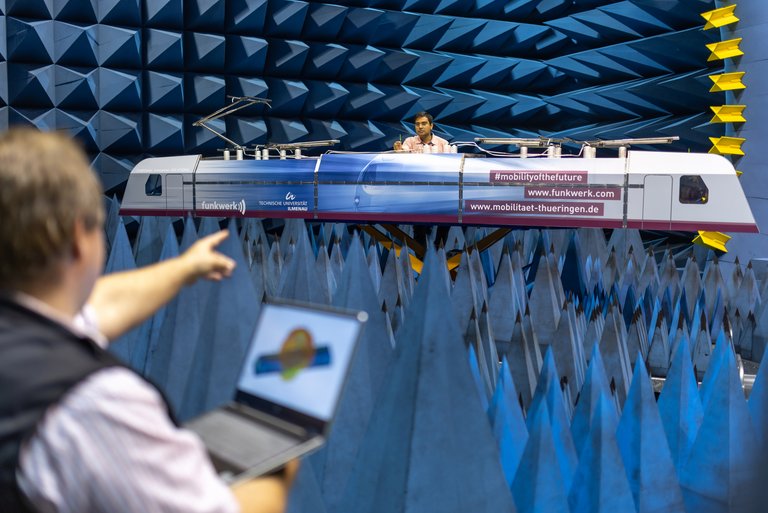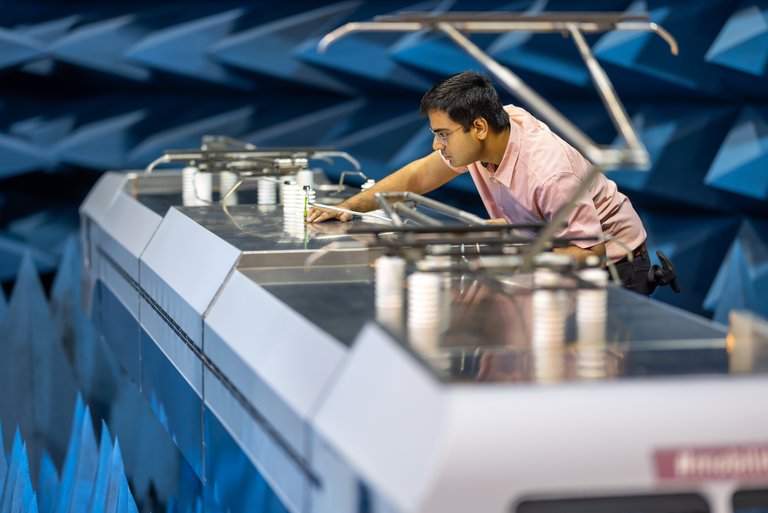In a recently completed research project at the Thuringian Innovation Center for Mobility, a five-member research team from TU Ilmenau has for the first time successfully studied the radiation behavior of antennas on locomotive roofs on a scaled-down model and thus made it accessible for measurement in laboratories. This opens up a simple way for engineers in research and development to develop and optimize antennas for innovative train radio systems in automated rail transport that meet future rail radio standards. The discoRAIL project "Digital services connected rail traffic" was implemented for Funkwerk Systems GmbH in Kölleda within one and a half years.

In a recently completed research project at the Thüringer Innovationszentrum Mobilität, a five-member research team from Technische Universität Ilmenau has for the first time successfully studied the radiation behavior of antennas on locomotive roofs on a scaled-down model and thus made it accessible for measurement in laboratories. This opens up a simple way for engineers in research and development to develop and optimize antennas for innovative train radio systems in automated rail traffic that meet future rail radio standards. The discoRAIL project "Digital services connected rail traffic" was implemented for Funkwerk Systems GmbH in Kölleda within one and a half years.
With the introduction of new radio technologies and the FRMCS standard - short for Future Railway Mobile Communication System - the second generation of a uniform European digital radio for railway operations, which will gradually replace today's digital operational radio GSM-R (Global System for Mobile Communications-Rail) in the coming years and herald the 5G era for train radio, new applications are emerging in automated and networked rail traffic, for which optimal antenna solutions must be researched and tested. Measuring and optimizing the antennas with high precision is the key to secure and robust radio communication and signaling. Before the antennas can be used in practice, however, they must be tested in their final installed state, ideally in anechoic measurement environments such as the shielded absorber chamber VISTA - Virtual Road Simulation and Test Facility - at the Thüringer Innovationszentrum Mobilität. However, the sheer size of locomotives makes tests in such research laboratories practically impossible. The Ilmenau researchers' idea for solving this problem: a true-to-scale replica of a locomotive model.
The number and quality of antennas required on locomotives is increasing rapidly
"The global demand for rail transport for passengers and freight is growing rapidly, not least in view of the EU's ambitious climate targets, and passenger and freight volumes will more than double by 2050," explains project leader Professor Matthias Hein: "The requirements of rail operators, the need for secure communication and signalling, and the desire for a networked environment on board are also causing the number and quality of the antennas required for this on the locomotives to increase rapidly." Before the antennas can be used in practice, their function must be evaluated and safeguarded. However, the chassis of the locomotive influences the radiation properties of the antennas so significantly that the test of the radio antennas must be carried out in the installed condition, i.e. together with the locomotive.

The research team of the RF and Microwave Research Group, which is part of the ThIMo Core Competence Field "Wireless and Information Technologies", has now for the first time conducted a study on a scaled-down model of a locomotive, which has the same shape and the same superstructures as the series under consideration, as part of the discoRAIL project. Compared to previous research on car antennas, the researchers had to overcome new challenges here, as locomotive roofs are much larger and more complex in structure than car roofs and differ from them, for example, in their stepped roof shape, current collectors or insulators. The computer-simulated and then metrologically examined test scenarios within the framework of the project therefore had a pilot character. Among other things, three-dimensional radiation patterns of the model scaled on a scale of 1:3 were examined in VISTA at frequencies between 2100 MHz and 7800 MHz, which correspond to real operating frequencies between 700 MHz and 2600 MHz.
Excellent correlation between measurement and simulation
As expected by the researchers, the influence of the different roof geometries, superstructures and mounting positions on the radiation patterns became more pronounced as the frequency increased. The researchers then compared these test results on the scale model with electromagnetic simulations of the original variant. The result: an excellent correlation between measurement and simulation of more than 98 %. Project manager Matthias Hein:
We have thus brought not only the road, but also the rail into the radio laboratory and added another dimension to the future of mobility.
Funkwerk Systems GmH is also highly satisfied with the systematic evaluation of the study, as it enables the design of new types of train antennas. Prof. Hein: "Such measurements pave the way for upcoming train radio standards with their high safety requirements as well as innovative applications for the protection and benefit of passengers, freight and operators."
For more information on research in the ThIMo core competence field of radio and information technology and in the specialist field of high-frequency and microwave technology, visit www.mobilitaet-thuerigen.de and www.tu-ilmenau.de/hmt/.
Univ.-Prof. Dr. rer. nat. habil. Matthias A. Hein
Director Thüringer Innovationszentrum Mobilität / Head of RF and Microwave Research Group

